Your search for * in food / earth oven prep has returned 36 entries
incacas

n. herb to 0. 75 m tall, flowers white (collection: Michael J. Balick #4953)
Example: The young leaves are edible; these should be collected, boiled for ca. 8 minutes and eaten with other foods such as cassava. This is one of the local leaves that is said to taste quite good when cooked and mixed with other foods. Both the ripe (red) and unripe (green) fruits are added to soup and other foods as a spice or eaten fresh. The fruit of this cultivar is very hot. The fruit is also fed to chickens who seem to love to eat it.
bookmarkinlop̃ot

inlopotjap

n. shrub to 2 m in height, flowers white. In agricultural field. (collection: Michael J. Balick #4951)
Example: The young leaves are used to protect food as it is being cooked on an earth oven. To prepare the oven, pile hot stones, then put a layer of leaves on the stones, and then place hot stones on top of the leaves. To make a hot oven, the stones are lined in a pit, a fire lit, more stones placed on firewood and the top layer of stones gets very hot. Then, remove the stones from the top of the wood, and cook food o the bottom layer of stones, add a layer of leaves, place the food on top of this, then cover with a layer of leaves and then pile the rest of the hot stones on top of the leaves.
bookmarkinlop̃otjap

inloptiri

n. shrub. Found in the village Unames. (collection: Ashley A McGuigan #32)
Example: 1. To cure when the anus falls out - Pound together 1 braches worth of inpalcapnesgin leaves and of both inloptiri (2-4 leaves, any age), also take the inner bark of nekeaitimi and nakhe. Put this into your hand, or another leaf and give it to the person to use it. This should be applied to the anus whenever the anus comes out. USed to use a clam shell to extract the bark but not anymore.
bookmarkinpa u natmas

n. tree. Growing near village. (collection: Ashley A McGuigan #13)
Example: 1. To cure toothache when pregnant - Take the inner bark from Intejed and boil it in a pot of seawater (about 1 liter) along with 2 leaves from each of inpoutnatmas, narayag, nahayag, and nelmaha. Boil until juice is visibly leaving the plants. Put this water into your mouth and hold it there for 2-3 minutes. Do this this with one cup in the morning, 1 cup in the afternoon, and 1 cup in the evening. 2. This plant is special and people grew it – use it after burial of a chief – wash hands with these leaves and water to cleanse the people who buried the chief. 3. Name means belongs to the spirit
bookmarkinrowod

n. unbranched treelet, 1. 25 m tall (collection: Gregory M. Plunkett #3526)
Example: People use the leaves for cooking any ground up food that is cooked on a fire such as manioc or bananas, roasted or boiled in water. Fish can be cooked this way. The roots of this plant can be cooked in an earth oven. These need to be cooked for 2 days or 2 nights, lke a yam. The plant has large roots that are good to eat. Chew like a piece of surgarcane, the taste is sweet like honey. Swallow the juice and spit out the fiber. The roots, once cooked, can be stored for 6 months. In ancient times they were eaten during times when there was no food. This food is said to be able to sustain a person for one day, if eaten in the morning, the person not be hungry until sunset. Today, people eat this plant at festivals, as it is no longer a famine food.
bookmarkintekes ~ inrowod

intop̃ asiej

n. herb, 1 m tall (collection: Gregory M. Plunkett #3221)
Example: This plant is used as a wild cabbage. The leaves are used to cover fish when baking in an earth oven and then these leaves are eaten. This is another "calendar plant" of Aneityum. When this plant flowers it means that turtles are very fat, so it is the indication that it’s time to go fishing for turtles. Also a "message plant." If a person wishes to break an agreement then the person puts the top leaves of this plant on another individual’s doorstep to indicate that the agreement is broken.
bookmarkintop̃asiej

n. shrub, 0. 7 m tall (collection: Gregory M. Plunkett #3562)
Example: In the past the ancestors learned to cook the leaves of this species with fish in an earth over and then eat the leaves as well as the fish. Today, fish are wrapped with small leaves and then covered with lap-lap leaf (Polyscias) and cooked in an earth oven. This plant is also a "calendar plant." When you see this plant flower you know that sea turtles are getting fat and ready to harvest. As a "message plant", if a person puts this flower behind their ear or in their hat, and looks at another person, it is an invitation to that person to go with you to the nakamal for kava
bookmarkkidie ~ kithi

n. shrub, 1. 5 m tall (collection: Gregory M. Plunkett #3205)
Example: 1. Plant this tree at each of the four corners of a fence to keep your pigs in and protect against a type of bad luck. If a man sleeps with his wife who is having her period, and then the man goes to see the pig, the pig will suffer and not grow strong and not have many piglets. So the presence of this plant controls against bad luck that others can bring to your pig farm. 2. This is an ornamental plant grown around the home. Sticks of this plant are planted around the outside of the garden and grow to create a fence, to protect the crops and keep them healthy, as well as protect the crops from people that are not cleansed in the ritual way. 3. This species is also planted around the house to add color and is very decorative in general. 4. For fertilizer in taro holes for water taro. For baly(?) taro and water taro, lay these flat on the surface of the charcoal, then lay the food – taro, cassava – on this and cover with another layer, add hot stones and cook. 4. Pig food, goat food.
bookmarknanec

n. tree, 7 m tall (collection: Gregory M. Plunkett #3633)
Example: To cook Alocasia (wild taro), use the dry wood of this plant as firewood. The leaves of this plant are also used to line the earth oven on top of the food and on bottom of the food to insulate it from the high heat of cooking.
bookmarknap̃ojev

n. well branched tree, 14 m tall (collection: Gregory M. Plunkett #3651)
Example: Poles made from this plant are used for house rafters and burned for firewood. To plant taro in a swampy area, collect the leaves of this species and put them in the hole where the taro is to be planted, mix with a bit of soil and then plant the taro on top of that. Leaves are a type of fertilizer. Used when baking with the earth oven. Hot stones cover the food and then the leaves from this plant cover the stones. The leaves stay on the branch.
bookmarknapojev

n. tree to 5 m, dbh 10 cm (collection: Michael J. Balick #4889)
Example: The leaves are used to cover meat when baking it in a stone oven (inmawum). This will soften the meat and keep it moist. Used when other species of this genus are not available, for example if you are in the bush.
bookmarknap̃ojev
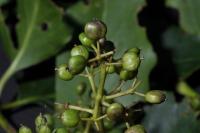
naupitju

n. treelet, 1 m tall (collection: Gregory M. Plunkett #3622)
Example: People use the leaf of this plant to tie over grated banana, taro or other foods for cooking in an earth oven or boiling in a pot. The root of this species is edible. Cook it for 2-3 nights in an earth oven and then chew and squeeze the juice into your mouth, spitting out the fiber. It is a survival food.
bookmarknauyerop̃ u inman
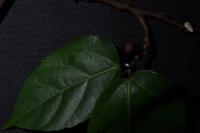
naytmas

n. tree to 5 m, dbh 4 cm (collection: Michael J. Balick #4898)
Example: The leaves are used to cover goat or pig meat when a person is roasting it on an earth oven It prevents it from burning and enhances the taste of the meat.
bookmarknecñanman

necñanman

nedouyatmas

nedouyatmas

nepya

n. tree, 6 m tall (collection: Gregory M. Plunkett #3541)
Example: 1. The young leaves are placed under a pig being cooked in the earth oven, on top of stones, the fat drips on the leaves and then people eat the leaves with pig fat on it--said to be delicious. The branches are used to make pig pen fences. 2. Collect top branches, chop leaves boil and eat like island cabbage – or cook on charcoal and wrap fish w/ this leaf.
bookmarknerere

n. tree to 10 m, dbh 75 cm (collection: Michael J. Balick #4988)
Example: The young aerial roots are cut from the stems of the tree and used as a local rope, to tie things, help construct temporary shelters, as well as to make string for a hunting bow. Flying foxes like to eat this fruit so in the night when the fruit is mature hunters come by this tree to hunt flying foxes as well as hunting birds during the day. Hunters use bows and arrows for birds, and throwing sticks (natou) made from any plant to hunt flying foxes.
bookmarkneroa

n. tree, 6 m tall (collection: Gregory M. Plunkett #3513)
Example: 1. The flower is used to make a necklace and the wood used as poles for a house roof. The flower is very fragrant and people put it behind their ear to enjoy the aroma. The leaf is used to bake taro in the earth oven. Use a fire to heat stones, then when the fire burns down and the stones are hot, pile these leaves on top of the hot stones and then place the food being cooked--taro, fish, pig, cassava, banana or other foods--on top of the leaves. Then pile more of these leaves on top of the food and then place additional hot stones on top of that pile of leaves. While the food is cooking--each type of food takes a different amount of time--the leaves give off a very nice smell and help flavor the food. 2. Firewood, flower smells good, put in coconut oil to give it aroma. Grate coconut, add small amount of water, put in bowl, heat until water is evaporated, the oil is on top, take all the coconut cream on bottom save oil in another pot. Drop 2-3 flowers into coconut oil and boil, or more flowers. Try not to burn the oil. Take out flowers and use pure oil. Also used for final covering of large earth oven during feast along with GMP 3503 – esp. wedding feast. Planting pole and hard and heavy wood – sharp end. 3. This is a "calendar plant." When it flowers, people know that the taro is ready to harvest.
bookmarkneroa

n. tree, 6-7 m tall (collection: Gregory M. Plunkett #3527)
Example: 1. The flower is used to make a necklace and the wood used as poles for a house roof. The flower is very fragrant and people put it behind their ear to enjoy the aroma. The leaf is used to bake taro in the earth oven. Use a fire to heat stones, then when the fire burns down and the stones are hot, pile these leaves on top of the hot stones and then place the food being cooked--taro, fish, pig, cassava, banana or other foods--on top of the leaves. Then pile more of these leaves on top of the food and then place additional hot stones on top of that pile of leaves. While the food is cooking--each type of food takes a different amount of time--the leaves give off a very nice smell and help flavor the food. 2. Firewood, flower smells good, put in coconut oil to give it aroma. Grate coconut, add small amount of water, put in bowl, heat until water is evaporated, the oil is on top, take all the coconut cream on bottom save oil in another pot. Drop 2-3 flowers into coconut oil and boil, or more flowers. Try not to burn the oil. Take out flowers and use pure oil. Also used for final covering of large earth oven during feast along with GMP 3503 – esp. wedding feast. Planting pole and hard and heavy wood – sharp end. 3. This is a "calendar plant." When it flowers, people know that the taro is ready to harvest.
bookmarkneroa

nese
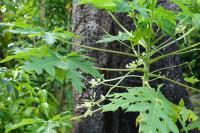
n. shrub to 2 m, flowers white. forest near house. (collection: Michael J. Balick #4871)
Example: A handful of flower buds are collected and put into water with 1-2 pieces of papaya roots. Heat the water and drink it hot for the treatment of hypertension or vein problems, or to promote circulation in overweight people. Do this treatment 1x a month. The white sap is collected and used to soften octopus flesh for eating. Put sap, fruits and chopped leaves in a bowl and add the octopus, allowing it to remain in the bowl for 1 hour--this will soften the flesh of the animal. The sap can be used to wash the skin of tough beef or wild pig--it helps to "burn" off (remove) the skin. When cooking tough meat, take young fruits of this tree and cut them up and put them in the pot with the meat, boil it to soften the meat which can then be cooked.
bookmarkneyo
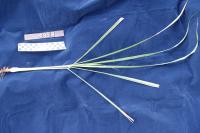
n. grass to 70 cm tall, sterile. Cultivated at the side of a field. (collection: Michael J. Balick #4958)
Example: The leaves and stems are boiled in water to make tea. The base of the leaves (the whitish part) is used to cook foods that have a strong odor, such as goat or shark. The base is sliced and put in the soup and this helps to keep the smell of the goat or shark from infusing through the rest of the food and making it less palatable. In some areas of Aneityum, such as in cassava fields, there is a fungus that kills the crops. This species is interplanted with the crops to kill that fungus and protect the crop plants.
bookmarkniegred

nigired
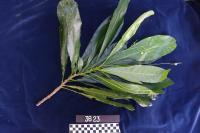
n. tree, 4 m tall (collection: Gregory M. Plunkett #3623)
Example: People use the leaf of this plant to layer on the bottom of the earth oven, and then pile food such as manioc or taro on it, then pile leaves of this species on top of that. This will help insulate the food from the high heat of the earth oven and allow it to cook better. Used especailly in feasts like weddings. Women usually collect this leaf and is used to cover very large earth ovens.
bookmarknigirid
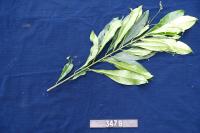
n. tree, 2 m tall (collection: Gregory M. Plunkett #3479)
Example: The leaves of this plant are used in cooking, particuarly with the earth oven. Use a fire to heat stones, then when the fire burns down and the stones are hot, pile these leaves on top of the hot stones and then place the food being cooked--taro, fish, pig, cassava, banana or other foods--on top of the leaves. Then pile more of these leaves on top of the food and then place additional hot stones on top of that pile of leaves. While the food is cooking--each type of food takes a different amount of time--the leaves give off a very nice smell and help flavor the food. The young stems of this plant are used in home construction but as they are small and thin, they are not used for posts.
bookmarknigirid
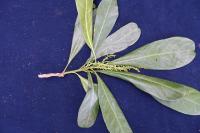
n. tree, 4 m tall (collection: Gregory M. Plunkett #3503)
Example: The leaves of this plant are used in cooking, particuarly with the earth oven. Use a fire to heat stones, then when the fire burns down and the stones are hot, pile these leaves on top of the hot stones and then place the food being cooked--taro, fish, pig, cassava, banana or other foods--on top of the leaves. Then pile more of these leaves on top of the food and then place additional hot stones on top of that pile of leaves. While the food is cooking--each type of food takes a different amount of time--the leaves give off a very nice smell and help flavor the food.
bookmarknuka
n. leaves for an oven
bookmarkucsiligei
v.a. to pare off rind
bookmark



